Foreword
This article refers to the address: http://
With the continuous development of automotive electronic technology, automotive sensors (automobile sensor types) are responsible for the collection and transmission of information in various systems of automobile engines, chassis and body. The control process of each system of automobiles relies on sensors to identify the outside world in time. Changes and changes in the system itself, and then control the work of the system itself based on the changed information. Therefore, automotive sensors play a very important role in the electronic control of automobiles (the role of automotive sensors). So, how do these sensors work? Xiao Bian simply analyzes and summarizes the sensor principles applied in different control systems of automobiles by collecting and collating data.
Introduction to the principle of car sensors in different positions
1, the principle of the temperature sensor outside the car
The outside temperature sensor is usually made of a thermistor, and its resistance changes when the temperature outside the car changes. When the temperature is low, the resistance is large, and when the temperature is high, the resistance is small.
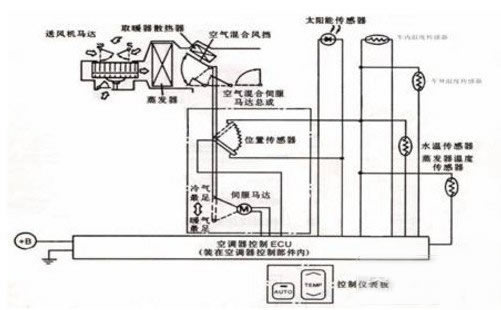
Compressor control principle
2, the principle of the temperature sensor inside the car
The interior temperature sensor also uses a thermistor material with a negative temperature coefficient. It is usually installed under the instrument panel and connected to the air conditioning vent pipe by an air tube. When the airflow passes quickly, the generated vacuum directs the air through the temperature sensor inside the vehicle.
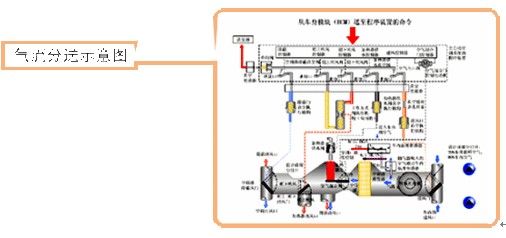
Air distribution diagram
3, the principle of sunshine sensor
The sun sensor is made of a photodiode or battery to sense the intensity of the sun shining on the vehicle, but not the temperature. Usually mounted above the dashboard.
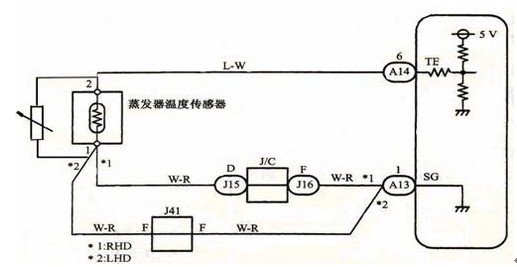
Evaporator temperature sensor control circuit
4, evaporator temperature sensor principle
The evaporator temperature sensor is typically mounted on the evaporator vane to accurately sense the temperature of the evaporator. It is also manufactured using a thermistor and has a negative temperature coefficient.
5, photoelectric crankshaft and camshaft position sensor principle
The working principle of the photoelectric sensor is shown in the figure.
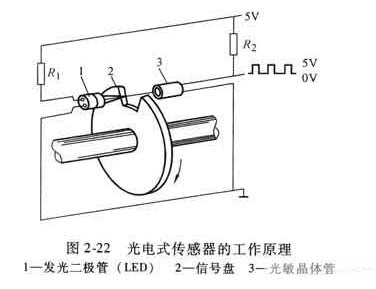
How photoelectric sensors work
The signal board is mounted between a light emitting diode (LED) and a photo transistor (or photodiode). When the light transmission hole on the signal plate rotates between the LED and the phototransistor, the light emitted by the LED will be irradiated onto the phototransistor, and the phototransistor is turned on, and the collector output is low (0.1 to 0.3 V) When the light-shielding portion of the signal disk is rotated between the LED and the phototransistor, the light emitted by the LED cannot be irradiated onto the phototransistor, and the phototransistor is turned off, and the collector output is high (4.8 to 5.2 V). .
If the signal disk is continuously rotated, the light-transmitting hole and the light-shielding portion are alternately rotated through the LED to transmit or block light, and the phototransistor collector alternately outputs a high level and a low level. When the sensor shaft rotates with the crankshaft and the valve camshaft, the light-transmitting hole and the light-shielding portion on the signal plate are rotated between the LED and the photo-transistor, and the light emitted by the LED is alternately illuminated by the light-transmitting and shading of the signal disk. On the phototransistor of the signal generator, a pulse signal corresponding to the crankshaft position and the camshaft position is generated in the signal sensor.
Since the crankshaft rotates two revolutions, the sensor shaft drives the signal disc to rotate one turn, so the G signal sensor will generate six pulse signals. The Ne signal sensor will generate 360 ​​pulse signals. Because the G signal light transmission hole interval arc is 60. The crankshaft rotates 120 per revolution. A pulse signal is generated, so usually the G signal is called 120.
6, the principle of magnetic induction sensor
The principle of the magnetic inductive sensor is shown in the figure.
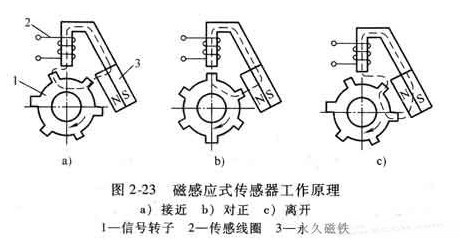
Principle of magnetic induction sensor
The path through which the magnetic lines of force pass is the air gap between the permanent magnet N pole and the rotor. The rotor teeth are the air gap between the rotor teeth and the stator head. The head is a magnetic head and a permanent magnet S pole. When the signal rotor rotates, the air gap in the magnetic circuit changes periodically, and the magnetic resistance of the magnetic circuit and the magnetic flux passing through the signal coil head periodically change. According to the principle of electromagnetic induction, an alternating electromotive force is induced in the sensing coil.
Since the air gap between the rotor teeth and the magnetic head directly affects the magnetic resistance of the magnetic circuit and the output voltage of the sensing coil, the air gap between the rotor teeth and the magnetic head cannot be arbitrarily changed during use. If the air gap changes, it must be adjusted according to the regulations. The air gap is generally designed to be in the range of 0.2 to 0.4 mm.
7. Hall-type crankshaft and camshaft position sensor principle
Hall sensor principle
Hall-type crankshaft and camshaft position sensors and other forms of Hall-type sensors are sensors based on the Hall effect.
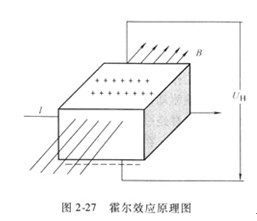
How Hall sensor works
How the Hall sensor works: When the sensor shaft rotates, the blade that triggers the impeller rotates through the air gap between the Hall IC and the permanent magnet: When the blade leaves the air gap, the magnetic flux of the permanent magnet passes through the Hall. The integrated circuit and the magnetic conductive steel sheet form a loop. At this time, the Hall element generates a voltage (UH=1.9-2.0V), the transistor of the Hall integrated circuit output stage is turned on, and the signal voltage U0 output by the sensor is low.
The signal voltage generated by the magnetic induction crank position sensor (CPS) and the Hall type camshaft position sensor (CIS) is continuously input to the electronic control unit (ECU) while the engine is operating. When the ECU receives the low level (15.) signal corresponding to the large position of the crank position sensor and the low level signal corresponding to the cam shaft position sensor window, it can be recognized that the piston of the cylinder 1 is in the compression stroke and the cylinder. 4 The piston is in the exhaust stroke, and the ignition advance angle is controlled according to the signal corresponding to the output of the small position of the crankshaft position sensor. After the electronic control unit recognizes the compression top dead center position of the cylinder 1, the sequential injection control and the ignition timing control of each cylinder can be performed.
If the engine produces a knocking, the electronic control unit can also determine which cylinder has generated a knock based on the signal input from the knocking sensor, thereby reducing the ignition advance angle to eliminate knocking.
to sum up
In the development of modern automotive electronic control applications, automotive sensors are mainly used in various systems of engines, chassis and body to achieve electronic control. This article mainly introduces several sensor principles applied in different positions of the car.
A Phone Screen Protector is an accessory for cell phones, Pads, tablet computers, and other devices that protects the screen and keeping your screen intact.
phone screen protector preserves your screen from scratches that can happen in everyday encounters, not to mention the rough and tumble environment of your bag. You can feel confident knowing your shield may take a beating, but your phone's screen will remain as smooth and clean as the day you bought it .
iPhone 6 plus screen protector makes your lovely iPhone 6 plus Screen Clean and Pristine. It can prevents oils from adhering to your screen which means smudges and fingerprints wipe away easily.
You can get glass phone screen protectors made out of tempered glass. Like with any technology, they have their own pros and cons.
Our screen protector use for , iPhone 6 , iPhone 6 plus , 7 plus , iPhone 8 , 8 plus and etc .
Phone Screen Protector
Phone Screen Protector, Clear Phone Screen Protector, Smart Phone Screen Protector, Glass Phone Screen Protector,Phone Glass Protector
Hebei Baisiwei Import&Export Trade Co., LTD. , https://www.baisiweicable.com